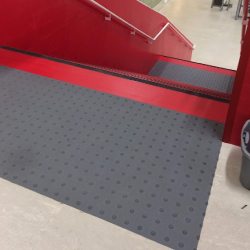









As facilities experience phenomenal daily footfall, meeting accessibility compliance through optimal tactile products in arenas and stadiums necessitates specialized consideration.
As suppliers of code-compliant accessibility solutions nationwide, we at Tactile Solution Canada recognize the immense pedestrian volumes endured daily by arenas and stadiums. Accommodating sold-out crowds and unrelenting footfall demands robust tactics to ensure their safety. This blog comprehensively delves into considering the ideal heavy-duty tactile solutions enabling inclusive navigation within such infrastructure.
As per provincial and national codes, all high-traffic public infrastructure necessitate Tactile Walking Surface Indicators (TWSIs) like directional cones and truncated domes. Their raised textures guide safe, independent movement for pedestrians with visual impairments. Daily, arenas/stadiums experience footfall exceeding most destinations, amplified by emergency evacuation requirements. Standard polymer TWSI longevity halves under such strain, jeopardizing accessibility and safety code compliance.
Arenas and stadiums accommodate enormous spectators during events alongside operational staff throughout their busy schedules. Tactile solutions play pivotal roles in:
Hazard Identification: Truncated dome tactile caution about platform drops or stairs at concourses, seating areas, etc.
Wayfinding Assistance: Direction bars guide safe movement amid dense crowds towards amenities like restrooms and concourses through crowded areas.
Emergency Evacuation Support: Exit signage including Ecoglo exit signs, ensures prompt evacuation, especially in poorly lit conditions, complying with standards.
Stair Edge Nosing: Non-slip photoluminescent stair nosings provide visibility and slip resistance in aisles or during emergencies.
High footfall translates to intensive abrasion, necessitating durable products that fulfill codes over decades of unimaginable usage.
Several factors require evaluation when choosing tactile solutions for these exceptional high-traffic locales:
Let's examine optimal tactile solutions matching these crucial specifications.
Quality TWSI withstands intensive abrasion, which is unavoidable in arenas/stadiums. Evaluating material durability remains pivotal:
Stainless Steel: Impervious to environmental damage with eternal slip resistance.
Porcelain: Temperature/impact-resistant clay resists degradation better than other materials.
Cast Iron: Unmatched compressive strength endures unimaginable dynamic/static loads unscathed.
Specialty Polymers: Reinforced composites combining mechanical integrity with corrosion-proofing surpass standard polymer longevity multi-fold.
Durable Rubber: Heavy-duty and flexible rubber made to last with full code compliance.
Specialized code-compliant yet affordable tactile warning systems from suppliers like Tactile Solution Canada deliver accessible designs optimized for such stringent usage conditions.
Vast event venues often require tailoring tactile products as per unique floorplans. Capabilities like:
Custom Sizing: Non-standard space must be flexibly accommodated through customized sizes, shapes and tile cutting.
Cast-In-Place Tactile Wayfinding Plate: Complex graphics, logos or venues' insignia stamped into tiles enhance aesthetics and wayfinding.
Radial Disks & Custom Angles: Unique circular areas or angled intersections are navigated ergonomically through meticulously shaped tactile.
Multiple Texture Options: Combining dome textures or direction lines on disks aids complex routing alongside hazards.
Collaboration: Consultation aids in designing integrated solutions that harmonize tactile elements optimally within the surrounding décor.
Specialized suppliers possess expertise in fabricating innovative yet standards-compliant customized tactile products for sprawling venues, enhancing usability.
Other aspects ensuring safe accessibility through such immense traffic include:
Periodic Replacements: Wear-monitoring and scheduled swaps prevent degradation, compromising slip resistance or visibility.
Maintenance Training: Crews comprehend gentle cleaning for tactile while immediately repairing minor damages.
Redundancy: Additional backup tactiles installed alongside main routes and critical junctions facilitate navigation if sections require maintenance or replacement.
Inspections: Access audits validate safety-compliant functionality amid intensifying degradation over decades of operations.
Professional stewardship maintains uninterrupted accessibility, safely serving all patrons even under relentless usage within these high-occupancy areas.
Whether cast-in during construction or surface-applied post-build, certified installers position TWSI precisely as per code. Owners proactively schedule replacement as texture erodes and uphold safety compliance throughout the infrastructure's lifespan.
While many tactile systems sufficing standard locales fail under such phenomenal usage, leveraging durable, heavy-duty solutions attains uninterrupted accessibility reliably. Specialized suppliers ensure this through expertise in code-compliant yet highly customized solutions for sprawling venues experiencing extraordinary footfall. Professional stewardship through vigilant maintenance practices moreover maintains unhindered safety.
Specifying industrial-strength TWSI from a specialist like Tactile Solution Canada furnishes assurance of welcoming all pedestrians safely for decades in arenas and stadiums. Contact us to enable fulfilling disability access mandates comprehensively within infrastructure of any scale.
A. Heavy-duty cast metals or porcelain offer 15-25+ years, while specialized composites/polymers rated for such usage withstand 10-15 years before proactive replacement.
A. No, each key application requires evaluating optimal materials per specific needs – stair nosings, signage, flooring, etc., require tailored solutions.
A. Annual inspections check for degradation, while minor repairs prevent compromising slip resistance or visibility. Tactiles continue functioning safely through attentive maintenance.
A. Replace tactiles before 30% texture loss to preserve slip-resistance and performance as per codes. Consider replacement every 7-10 years for busiest infrastructure.
